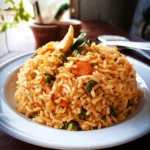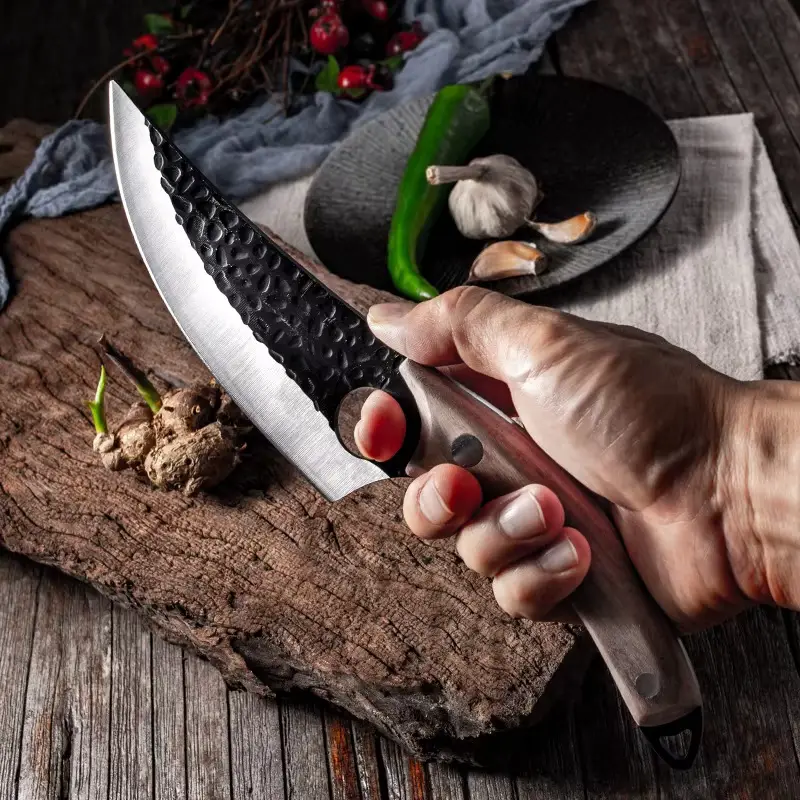Okay, let’s dive into the vibrant and utterly delicious world of Nigerian Fried Rice! This isn’t just any fried rice; it’s a celebration on a plate, a symphony of colors, textures, and unforgettable flavors. I remember the first time I truly mastered this dish. For years, my attempts were… decent, but they lacked that “wow” factor, that authentic party taste I craved. Then, after much trial, error, and invaluable tips from my aunties, it finally clicked. The aroma alone filled my home with such warmth and anticipation. When I served it at our next family gathering, the silence, punctuated only by the clinking of forks and satisfied sighs, was the highest compliment. My kids, usually picky eaters, asked for seconds, and my husband declared it “the best fried rice, period.” It’s become a staple for birthdays, holidays, or even just a weekend treat when we want something special. The beauty of Nigerian Fried Rice lies in its medley of vegetables, the perfectly cooked rice grains, and that unique blend of seasonings that sets it apart. It’s more than food; it’s a culinary experience that brings joy and togetherness.
The Heart of the Feast: Ingredients for Authentic Nigerian Fried Rice
To create this masterpiece, you’ll need a vibrant array of fresh ingredients. The key is quality and a good balance. Here’s what you’ll need:
- For the Rice:
- Rice: 3 cups (about 600g) long-grain parboiled rice (Basmati or Sella Basmati works wonderfully)
- Water or Broth: 6-7 cups for parboiling (or as needed)
- Butter or Margarine: 2 tablespoons (for cooking rice, optional but adds flavor)
- Salt: 1 teaspoon (for cooking rice)
- For the Protein & Aromatics:
- Chicken Breast or Thighs: 1 lb (about 450g), boneless, skinless, cut into small cubes
- Beef Liver (optional but highly recommended): ½ lb (about 225g), cleaned and diced small
- Shrimp (optional): ½ lb (about 225g), peeled and deveined
- Vegetable Oil: ¼ cup (60ml), plus more as needed for frying
- Onion: 1 large, finely chopped
- Garlic: 3-4 cloves, minced
- Ginger: 1-inch piece, grated or minced (optional, but adds a nice zing)
- Scotch Bonnet Pepper (Ata Rodo): 1-2, finely minced (adjust to your heat preference, deseed for less heat)
- For the Vegetables (The Rainbow Medley):
- Carrots: 2 large, diced small
- Green Beans: 1 cup (about 150g), trimmed and diced small
- Sweet Corn: 1 can (15oz/425g), drained, or 1 ½ cups frozen, thawed
- Green Peas: 1 cup (about 150g), frozen, thawed
- Bell Peppers: 1 red, 1 green, 1 yellow (or any combination), cored, deseeded, and diced small
- Spring Onions (Scallions): 4-5 stalks, chopped (greens and whites separated)
- For the Seasoning & Flavor Base:
- Chicken or Beef Broth: 1 – 1.5 cups (240-360ml), preferably homemade or good quality store-bought (use reserved from boiling chicken/liver if applicable)
- Curry Powder (Nigerian type, e.g., Ducros or similar): 2-3 tablespoons (this is a key flavor!)
- Dried Thyme: 1 tablespoon
- Seasoning Cubes (e.g., Maggi, Knorr): 2-3 cubes, crushed
- Salt: To taste (be mindful of salt in broth and seasoning cubes)
- Black Pepper: 1 teaspoon, or to taste
- Soy Sauce (Light): 1-2 tablespoons (optional, for umami and slight color)
- Dark Soy Sauce (optional, for deeper color): 1 teaspoon (use sparingly)
A Note on Ingredients:
The beauty of Nigerian Fried Rice is its adaptability. Feel free to adjust vegetable quantities based on preference. Some people add diced fried plantains, others might include different types of sausages (like frankfurters, chopped). The core, however, remains the distinct seasoning blend and the method of preparation.
Crafting the Masterpiece: Step-by-Step Instructions
Patience and organization are your best friends here. Prep all your ingredients (mise en place) before you start cooking – it makes the process much smoother.
Phase 1: Preparing the Core Components
- Cook the Protein:
- If using chicken, season the cubed chicken with a pinch of salt, black pepper, 1 crushed seasoning cube, and 1 teaspoon of curry powder. Heat 1 tablespoon of vegetable oil in a large skillet or wok over medium-high heat. Add the chicken and cook until golden brown and cooked through. Remove and set aside.
- If using beef liver, boil it in lightly salted water with a bay leaf and half an onion (for flavor) until just cooked through (about 10-15 minutes). Allow to cool slightly, then dice into small pieces. You can lightly fry these pieces in a little oil for extra flavor, or add them directly later. Reserve the liver broth if desired.
- If using shrimp, season with a pinch of salt and pepper. Briefly sauté in a little oil until pink and cooked. Set aside. Do not overcook.
- Parboil the Rice (Crucial Step for Nigerian Fried Rice Texture):
- Rinse the long-grain parboiled rice thoroughly under cold running water until the water runs clear. This removes excess starch.
- In a large pot, bring 6-7 cups of water (or a mix of water and some of your reserved chicken/liver broth for extra flavor) to a rolling boil. Add 1 teaspoon of salt, 1 tablespoon of curry powder, and 1 teaspoon of dried thyme.
- Add the rinsed rice to the boiling water. Stir once.
- Cook for 8-10 minutes, or until the rice is about 70% cooked (al dente – firm to the bite but not crunchy, and the grains should still be somewhat separate, not mushy). The goal is not to cook it fully.
- Drain the rice immediately in a colander and rinse with cold water to stop the cooking process and wash off any remaining surface starch. Fluff with a fork and set aside. This parboiling method is what gives Nigerian Fried Rice its characteristic separated grains.
- Prepare the Vegetables:
- Wash, dice, and chop all your vegetables (carrots, green beans, bell peppers, onions, spring onions, garlic, ginger, scotch bonnet). Keep them in separate bowls for easy addition. Thaw frozen peas and drain canned corn.
Phase 2: Building the Flavor Base
- Sauté Aromatics:
- Place a large, heavy-bottomed pot, Dutch oven, or a very large wok over medium heat. Add the ¼ cup of vegetable oil.
- Once the oil is hot, add the chopped white parts of the spring onions and the main onion. Sauté for 2-3 minutes until softened and fragrant.
- Add the minced garlic, grated ginger (if using), and minced scotch bonnet pepper. Sauté for another 1-2 minutes until fragrant. Be careful not to burn the garlic.
- Incorporate Proteins and Initial Seasoning:
- Add the cooked chicken (and fried liver, if using) to the pot. Stir well.
- Add the remaining curry powder (1-2 tablespoons), dried thyme (remaining), crushed seasoning cubes, and black pepper. Stir everything together to coat the proteins and aromatics, cooking for about 2-3 minutes to toast the spices and deepen the flavor.
Phase 3: Adding Vegetables and Rice
- Cook the Harder Vegetables:
- Add the diced carrots and green beans to the pot. Stir-fry for 3-5 minutes until they are slightly tender-crisp. You want them cooked but still with a bit of a bite.
- Introduce the Rice:
- Add the parboiled rice to the pot in batches, stirring gently after each addition to combine it with the seasoned proteins and vegetables without mashing the grains.
- Pour in about 1 to 1.5 cups of chicken or beef broth (or the reserved liver broth). The amount of broth will depend on how cooked your rice was after parboiling. You want just enough to help steam the rice fully and meld the flavors, not make it soggy.
- If using, add the soy sauce (light and/or dark) at this stage for color and umami. Start with a smaller amount and add more if needed.
- Steam and Infuse:
- Stir everything gently to ensure even distribution of ingredients and seasonings. Taste and adjust seasoning if necessary (salt, more seasoning cube, pepper).
- Reduce the heat to low, cover the pot tightly with a lid (you can place a sheet of foil under the lid for a tighter seal), and let the rice steam for 15-20 minutes, or until all the liquid has been absorbed and the rice is tender and fluffy. Avoid opening the lid frequently.
Phase 4: Finishing Touches
- Add Softer Vegetables and Final Protein:
- Once the rice is cooked, uncover the pot. Add the diced bell peppers, sweet corn, green peas, and cooked shrimp (if using).
- Gently stir everything together to incorporate the fresh vegetables. The residual heat will cook them perfectly, keeping them vibrant and slightly crunchy.
- The Final Flourish:
- Stir in the chopped green parts of the spring onions for a burst of freshness and color.
- A traditional and highly recommended step: Add 1-2 tablespoons of butter or margarine on top of the hot rice. Cover the pot again and let it sit off the heat for 5-10 minutes. The butter will melt into the rice, adding a lovely sheen and richness.
- Serve:
- Fluff the Nigerian Fried Rice gently with a fork before serving. Admire the beautiful colors and inhale the incredible aroma!
Understanding Your Plate: Nutrition Facts
- Servings: This recipe typically yields 6-8 generous servings.
- Calories per serving (approximate): Between 450-600 calories.
Disclaimer: The exact nutritional information can vary significantly based on the specific ingredients used (e.g., type and amount of oil, inclusion of liver/shrimp, fat content of chicken), portion sizes, and any modifications.
The dish is a good source of carbohydrates from the rice, protein from the chicken/liver/shrimp, and vitamins and fiber from the abundant vegetables. The curry powder and thyme also offer some micronutrients and antioxidants.
Timing is Everything: Preparation and Cook Time
- Preparation Time: 45-60 minutes (This includes washing and chopping all vegetables, dicing meat, and parboiling rice. Good knife skills and organization can speed this up).
- Cook Time: 45-55 minutes (This includes cooking proteins, sautéing, and steaming the rice).
- Total Time: Approximately 1 hour 30 minutes to 2 hours.
While it might seem like a lengthy process, much of the cooking time is hands-off (like rice steaming). The prep work is key; once that’s done, the cooking flows relatively quickly.
Serving Suggestions: Elevate Your Nigerian Fried Rice Experience
Nigerian Fried Rice is a star in its own right but also pairs beautifully with a variety of accompaniments. Here are some popular ways to serve it:
- As a Standalone Meal: It’s hearty and complete enough to be enjoyed on its own, especially for a satisfying lunch or dinner.
- Classic Party Pairings:
- Fried Chicken or Grilled Chicken: A piece of crispy fried chicken or smoky grilled chicken is a classic accompaniment.
- Moin Moin: Steamed bean pudding, either savory or slightly sweet, offers a wonderful textural contrast.
- Coleslaw: A creamy, crunchy Nigerian-style coleslaw (often with less mayo and more vinaigrette-like dressing) adds freshness.
- Fried Plantains (Dodo): Sweet, caramelized fried ripe plantains are an irresistible side.
- Salad: A simple green salad or a Nigerian vegetable salad can balance the richness.
- For Festive Occasions:
- Serve alongside Jollof Rice for the ultimate Nigerian party experience (often a friendly rivalry exists between these two dishes!).
- Include other small chops (Nigerian appetizers) like puff puff, samosas, or spring rolls.
- Presentation:
- Garnish with extra chopped spring onions or a sprig of parsley.
- Serve in a large platter for family-style sharing or in individual bowls.
- A slice of lime or lemon on the side can add a fresh zing if desired.
Pro Tips for Perfect Nigerian Fried Rice Every Time
- Master the Parboil: Don’t skip or rush the parboiling step for the rice. It’s the secret to achieving those perfectly separated, non-mushy grains that are characteristic of authentic Nigerian Fried Rice. Rinsing thoroughly before and after parboiling is crucial.
- Don’t Overcrowd the Pan: Especially when stir-frying the vegetables and initially combining with the rice. If your pot isn’t large enough, it’s better to fry in batches to ensure everything cooks evenly and gets that slight char rather than steaming and becoming soggy. A large, heavy-bottomed wok or Dutch oven is ideal.
- High Heat for Stir-Frying, Low Heat for Steaming: Use medium-high to high heat when stir-frying your vegetables and proteins to get a nice sear and keep them crisp. Once the rice and broth are added for the final cook, reduce the heat to low and cover tightly to allow the rice to steam perfectly.
- Freshness is Key (Especially for Veggies): While frozen peas and corn are fine, try to use fresh carrots, bell peppers, and green beans. Their crunch and vibrant color make a huge difference. Chop them uniformly for even cooking and better presentation.
- Season in Layers & Taste As You Go: Season your proteins separately, season the water for parboiling rice, and season the main pot when building the flavor base. Crucially, taste the broth/sauce before adding all the rice, and then taste again before the final steaming. Adjust salt, seasoning cubes, curry, and pepper as needed. This ensures a well-rounded, deeply flavorful dish.
Your Questions Answered: Nigerian Fried Rice FAQ
Q1: What’s the main difference between Nigerian Fried Rice and Jollof Rice?
A1: They are both iconic Nigerian rice dishes but differ significantly.
* Nigerian Fried Rice: Made with parboiled long-grain rice that is then stir-fried with a medley of mixed vegetables, proteins (chicken, liver, shrimp), and seasoned primarily with curry powder, thyme, and seasoning cubes. It has a yellow/golden hue and distinct, separate grains.
* Jollof Rice: Cooked in a single pot with a rich tomato and pepper-based sauce, along with onions, spices (thyme, curry, bay leaf), and often chicken or beef. It has a characteristic reddish-orange color and a smoky flavor, with the rice absorbing all the sauce.
Q2: Can I make Nigerian Fried Rice vegetarian or vegan?
A2: Absolutely! To make it vegetarian, simply omit the meat and shrimp. You can add fried tofu, tempeh, or more mushrooms for a protein element. Ensure your seasoning cubes and broth are vegetable-based. For a vegan version, also replace any butter/margarine with a vegan alternative or use a little extra oil. The abundance of vegetables already makes it a great base for a plant-based meal.
Q3: What’s the best type of rice to use for Nigerian Fried Rice?
A3: Long-grain parboiled rice is non-negotiable for the authentic texture. Brands like Golden Sella Basmati or any good quality long-grain parboiled rice work best. This type of rice has been partially boiled in the husk, which helps it retain its shape, absorb flavors well, and result in separate, fluffy grains when cooked correctly, preventing mushiness. Avoid short-grain or sticky rice.
Q4: How do I prevent my Nigerian Fried Rice from becoming mushy?
A4: Several factors contribute to non-mushy fried rice:
* Use long-grain parboiled rice.
* Parboil correctly: Don’t overcook the rice during the initial parboiling stage (aim for ~70% cooked).
* Rinse thoroughly: Rinse before parboiling and after to remove excess starch.
* Don’t add too much liquid/broth: Add just enough broth for the final steaming stage. Too much liquid will make it soggy.
* Avoid over-stirring: Stir gently, especially after adding the rice, to prevent breaking the grains.
* Don’t cover immediately after stir-frying: If you’ve stir-fried the rice with veggies, let some steam escape before covering for the final steaming on low heat.
Q5: How should I store and reheat leftover Nigerian Fried Rice?
A5:
* Storage: Allow the fried rice to cool completely, then store it in an airtight container in the refrigerator for up to 3-4 days. For longer storage, you can freeze it for up to 2-3 months, though the texture of the vegetables might change slightly upon thawing.
* Reheating:
* Microwave: Place in a microwave-safe dish, sprinkle with a tablespoon of water (to add moisture), cover loosely, and heat until warmed through, stirring midway.
* Stovetop: Heat a little oil or butter in a skillet or wok over medium heat. Add the rice and stir-fry until heated through. You might need to add a splash of water or broth if it seems dry. This method often revives the flavors and texture best.

Authentic Nigerian Fried Rice Recipe
Ingredients
- For the Rice:
- Rice: 3 cups (about 600g) long-grain parboiled rice (Basmati or Sella Basmati works wonderfully)
- Water or Broth: 6-7 cups for parboiling (or as needed)
- Butter or Margarine: 2 tablespoons (for cooking rice, optional but adds flavor)
- Salt: 1 teaspoon (for cooking rice)
- For the Protein & Aromatics:
- Chicken Breast or Thighs: 1 lb (about 450g), boneless, skinless, cut into small cubes
- Beef Liver (optional but highly recommended): ½ lb (about 225g), cleaned and diced small
- Shrimp (optional): ½ lb (about 225g), peeled and deveined
- Vegetable Oil: ¼ cup (60ml), plus more as needed for frying
- Onion: 1 large, finely chopped
- Garlic: 3-4 cloves, minced
- Ginger: 1-inch piece, grated or minced (optional, but adds a nice zing)
- Scotch Bonnet Pepper (Ata Rodo): 1-2, finely minced (adjust to your heat preference, deseed for less heat)
- For the Vegetables (The Rainbow Medley):
- Carrots: 2 large, diced small
- Green Beans: 1 cup (about 150g), trimmed and diced small
- Sweet Corn: 1 can (15oz/425g), drained, or 1 ½ cups frozen, thawed
- Green Peas: 1 cup (about 150g), frozen, thawed
- Bell Peppers: 1 red, 1 green, 1 yellow (or any combination), cored, deseeded, and diced small
- Spring Onions (Scallions): 4-5 stalks, chopped (greens and whites separated)
- For the Seasoning & Flavor Base:
- Chicken or Beef Broth: 1 – 1.5 cups (240-360ml), preferably homemade or good quality store-bought (use reserved from boiling chicken/liver if applicable)
- Curry Powder (Nigerian type, e.g., Ducros or similar): 2-3 tablespoons (this is a key flavor!)
- Dried Thyme: 1 tablespoon
- Seasoning Cubes (e.g., Maggi, Knorr): 2-3 cubes, crushed
- Salt: To taste (be mindful of salt in broth and seasoning cubes)
- Black Pepper: 1 teaspoon, or to taste
- Soy Sauce (Light): 1-2 tablespoons (optional, for umami and slight color)
- Dark Soy Sauce (optional, for deeper color): 1 teaspoon (use sparingly)
Instructions
Phase 1: Preparing the Core Components
- Cook the Protein:
- If using chicken, season the cubed chicken with a pinch of salt, black pepper, 1 crushed seasoning cube, and 1 teaspoon of curry powder. Heat 1 tablespoon of vegetable oil in a large skillet or wok over medium-high heat. Add the chicken and cook until golden brown and cooked through. Remove and set aside.
- If using beef liver, boil it in lightly salted water with a bay leaf and half an onion (for flavor) until just cooked through (about 10-15 minutes). Allow to cool slightly, then dice into small pieces. You can lightly fry these pieces in a little oil for extra flavor, or add them directly later. Reserve the liver broth if desired.
- If using shrimp, season with a pinch of salt and pepper. Briefly sauté in a little oil until pink and cooked. Set aside. Do not overcook.
- Parboil the Rice (Crucial Step for Nigerian Fried Rice Texture):
- Rinse the long-grain parboiled rice thoroughly under cold running water until the water runs clear. This removes excess starch.
- In a large pot, bring 6-7 cups of water (or a mix of water and some of your reserved chicken/liver broth for extra flavor) to a rolling boil. Add 1 teaspoon of salt, 1 tablespoon of curry powder, and 1 teaspoon of dried thyme.
- Add the rinsed rice to the boiling water. Stir once.
- Cook for 8-10 minutes, or until the rice is about 70% cooked (al dente – firm to the bite but not crunchy, and the grains should still be somewhat separate, not mushy). The goal is not to cook it fully.
- Drain the rice immediately in a colander and rinse with cold water to stop the cooking process and wash off any remaining surface starch. Fluff with a fork and set aside. This parboiling method is what gives Nigerian Fried Rice its characteristic separated grains.
- Prepare the Vegetables:
- Wash, dice, and chop all your vegetables (carrots, green beans, bell peppers, onions, spring onions, garlic, ginger, scotch bonnet). Keep them in separate bowls for easy addition. Thaw frozen peas and drain canned corn.
Phase 2: Building the Flavor Base
- Sauté Aromatics:
- Place a large, heavy-bottomed pot, Dutch oven, or a very large wok over medium heat. Add the ¼ cup of vegetable oil.
- Once the oil is hot, add the chopped white parts of the spring onions and the main onion. Sauté for 2-3 minutes until softened and fragrant.
- Add the minced garlic, grated ginger (if using), and minced scotch bonnet pepper. Sauté for another 1-2 minutes until fragrant. Be careful not to burn the garlic.
- Incorporate Proteins and Initial Seasoning:
- Add the cooked chicken (and fried liver, if using) to the pot. Stir well.
- Add the remaining curry powder (1-2 tablespoons), dried thyme (remaining), crushed seasoning cubes, and black pepper. Stir everything together to coat the proteins and aromatics, cooking for about 2-3 minutes to toast the spices and deepen the flavor.
Phase 3: Adding Vegetables and Rice
- Cook the Harder Vegetables:
- Add the diced carrots and green beans to the pot. Stir-fry for 3-5 minutes until they are slightly tender-crisp. You want them cooked but still with a bit of a bite.
- Introduce the Rice:
- Add the parboiled rice to the pot in batches, stirring gently after each addition to combine it with the seasoned proteins and vegetables without mashing the grains.
- Pour in about 1 to 1.5 cups of chicken or beef broth (or the reserved liver broth). The amount of broth will depend on how cooked your rice was after parboiling. You want just enough to help steam the rice fully and meld the flavors, not make it soggy.
- If using, add the soy sauce (light and/or dark) at this stage for color and umami. Start with a smaller amount and add more if needed.
- Steam and Infuse:
- Stir everything gently to ensure even distribution of ingredients and seasonings. Taste and adjust seasoning if necessary (salt, more seasoning cube, pepper).
- Reduce the heat to low, cover the pot tightly with a lid (you can place a sheet of foil under the lid for a tighter seal), and let the rice steam for 15-20 minutes, or until all the liquid has been absorbed and the rice is tender and fluffy. Avoid opening the lid frequently.
Phase 4: Finishing Touches
- Add Softer Vegetables and Final Protein:
- Once the rice is cooked, uncover the pot. Add the diced bell peppers, sweet corn, green peas, and cooked shrimp (if using).
- Gently stir everything together to incorporate the fresh vegetables. The residual heat will cook them perfectly, keeping them vibrant and slightly crunchy.
- The Final Flourish:
- Stir in the chopped green parts of the spring onions for a burst of freshness and color.
- A traditional and highly recommended step: Add 1-2 tablespoons of butter or margarine on top of the hot rice. Cover the pot again and let it sit off the heat for 5-10 minutes. The butter will melt into the rice, adding a lovely sheen and richness.
- Serve:
- Fluff the Nigerian Fried Rice gently with a fork before serving. Admire the beautiful colors and inhale the incredible aroma!
Nutrition
- Serving Size: One Normal Portion
- Calories: 450-600




